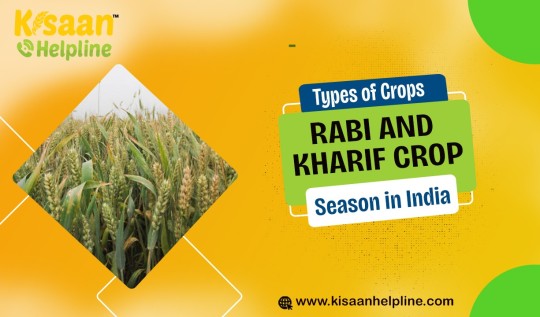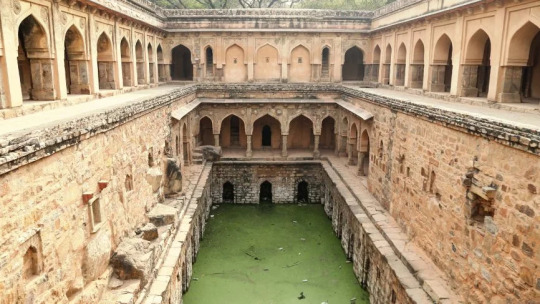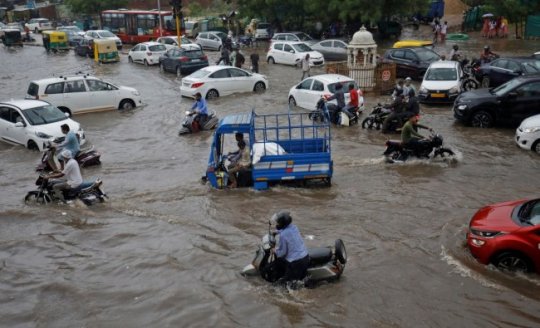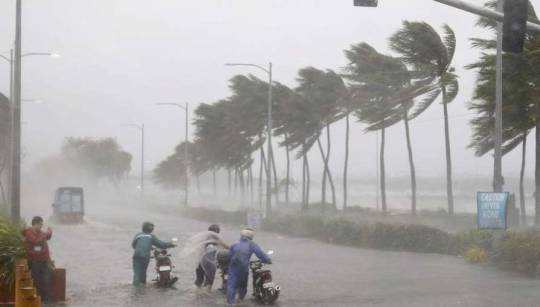#Gujarat rainfall
Text
Gujarat: 20 dead in lightning strikes amid unseasonal rainfall
PTI reports a tragic toll of twenty lives lost in Gujarat due to lightning strikes during unseasonal rainfall across various districts. Dahod, Bharuch, Tapi, Ahmedabad, Amreli, Banaskantha, Botad, Kheda, Mehsana, Panchmahal, Sabarkantha, Surat, Surendranagar, and Devbhumi Dwarka were affected, as confirmed by the State Emergency Operation Centre (SEOC).

Yesterday's storms claimed eight lives, including a biker in Botad and a man in Mehsana hit by a falling tree. Two farmers in Tapi and one in Sabarkantha, Ahmedabad, Mehsana, and Dahod also succumbed to lightning strikes amid the heavy rain.
Reportedly, 220 of 251 talukas in Gujarat received substantial rainfall, with Ahmedabad city experiencing 15 mm. The Indian Meteorological Department (IMD) attributed this unusual weather to a cyclonic circulation over the northeast Arabian Sea and nearby Saurashtra-Kutch regions.
IMD forecasts a decrease in rain activity by Monday, concentrating in select areas of south Gujarat and Saurashtra. Additionally, rainfall alerts have been issued for parts of Maharashtra, Rajasthan, and southwest Madhya Pradesh. IMD anticipates light to moderate rain in isolated areas of Punjab, Haryana, West Uttar Pradesh, Jammu and Kashmir, and Himachal Pradesh.
In a late-night update on 'X,' IMD alerted about impending rainfall with thunderstorms, gusty winds, and hailstorms in regions colored orange and red (south Rajasthan, Maharashtra, southwest Madhya Pradesh) within the next 2-3 hours. Regular updates are underway to track the situation.
0 notes
Text
#Lightning strikes#Gujarat#rain-related incidents#thunderstorms#hailstorms#heavy rainfall#24 dead#23 injured#Indian state#government officials#weather calamity#Chandrashekar Bhat#Gujarat news#rain havoc#natural disasters#lightning fatalities#monsoon havoc#disaster updates#weather news#India rain#emergency response#rain disaster#weather-related casualties#Gujarat rainfall#Monday storm#Sunday thunderstorms#rain damage#lightning incidents#state government data
0 notes
Text
Monsoon Weather News Updates: Heavy rainfall in East Rajasthan, more rains expected in next 4-5 days
Monsoon Weather News Updates: Heavy rainfall in East Rajasthan, more rains expected in next 4-5 days
In a relief to Delhiites, several parts of the capital received light to moderate rain on Saturday. However, two flights coming from Bengaluru and Kolkata to Delhi were diverted to Amritsar and Jaipur, respectively, due to bad weather at Delhi. Airport sources said nearly 20 flights were delayed. The Met department has predicted very light rain or drizzle at one or two places on Sunday, but rain…

View On WordPress
#days#delhi rainfall#Delhi rains#Delhi-NCR weather#East#Expected#Flood alerts#gujarat death#gujarat flood#gujarat rain today#Gujarat rains#heavy#maharashtra heavy rains#maharashtra rainfall#mausam#monsoon#Monsoon 2022#Monsoon News#mp rains#News#Odisha#Rainfall#Rains#Rajasthan#Tamil Nadu Weather#UP weather#updates#uttarakhand heavy rains#uttarakhand imd alert#uttarakhand rainfall alert
0 notes
Text
Weather Patterns and Castor Seed Mandi Prices in Gujarat: Insights from Book My Crop Pvt Ltd
Weather Patterns and Castor Seed Mandi Prices in Gujarat: Insights from Book My Crop Pvt Ltd
Welcome to the official blog of Book My Crop Pvt Ltd, your go-to source for all things related to agricultural commodities. Today, we delve into the fascinating interplay between weather patterns and castor seed mandi prices in Gujarat, offering valuable insights for farmers, traders, and enthusiasts alike.
Understanding the Impact of Weather Patterns
Weather patterns play a crucial role in agricultural production, influencing crop yields and market dynamics. In Gujarat, where castor cultivation thrives, weather fluctuations can have a significant impact on mandi prices. From monsoon rains to temperature variations, every change in weather brings forth a ripple effect that reverberates throughout the castor seed market.
Navigating Market Volatility
The volatile nature of weather patterns poses both challenges and opportunities for stakeholders in the castor seed industry. Fluctuations in rainfall, for instance, can affect soil moisture levels and ultimately, crop yields. Similarly, extreme temperatures may impact plant health and productivity.
Insights from Book My Crop Pvt Ltd
At Book My Crop Pvt Ltd, we understand the importance of staying ahead of the curve. Our team of experts closely monitors weather patterns and their implications on castor seed mandi prices in Gujarat. Through our comprehensive analysis and real-time updates, we provide valuable insights that empower our clients to make informed decisions in a dynamic market environment.
Buy Castor Seeds Online: A Seamless Solution
In the midst of changing weather patterns and market volatility, convenience is key. That's why Book My Crop Pvt Ltd offers a hassle-free online platform where you can buy castor seeds with ease. Whether you're a farmer looking to replenish your stock or a trader seeking to capitalize on market opportunities, our user-friendly interface ensures a seamless experience from start to finish.
Conclusion: Navigating the Nexus of Weather and Market Dynamics
In conclusion, weather patterns play a pivotal role in shaping castor seed mandi prices in Gujarat. By understanding the intricate relationship between weather fluctuations and market dynamics, stakeholders can adapt their strategies to mitigate risks and seize opportunities. At Book My Crop Pvt Ltd, we are committed to providing the insights, tools, and resources needed to thrive in today's ever-evolving agricultural landscape.
Stay tuned for more updates, analyses, and innovations from Book My Crop Pvt Ltd. Together, we can navigate the nexus of weather and market dynamics, forging a path towards prosperity in the castor seed industry.
Happy trading!
1 note
·
View note
Text
Journey to Gir National Park for an Enchanting Lion Safari
Gir National Park, situated in the western state of Gujarat, is not just a sanctuary; it's a haven for wildlife enthusiasts seeking the majestic Asiatic lions. Planning a trip to Gir involves careful considerations to ensure a seamless and memorable safari experience. In this comprehensive guide, we'll walk you through the essential steps to reach Gir National Park and embark on an enchanting lion safari.

1. Plan Your Itinerary: Setting the Stage for Adventure
Before embarking on your journey, plan a detailed itinerary. Determine the duration of your stay, the activities you wish to indulge in, and the specific zones within Gir National Park you want to explore. The park is divided into different zones, each offering a unique wildlife experience.
2. Choose the Right Season: Optimal Wildlife Viewing
Gir National Park is open from mid-October to mid-June, with the best time for wildlife viewing being from December to March. During these months, the weather is pleasant, and the animals are more active. Avoid planning your visit during the monsoon season (June to September) when the park is usually closed due to heavy rainfall.
3. Select Accommodations: Stay Close to the Wilderness
Numerous accommodations, ranging from budget to luxury, are available in and around Gir National Park. Opt for lodges or resorts that offer a proximity to the park's entrance gates. This not only enhances your wildlife experience but also ensures you make the most of your time in Gir.
4. Reach Gir by Air, Rail, or Road: Choosing the Best Mode of Travel
By Air: The nearest airport to Gir is Diu Airport, approximately 110 kilometers away. Alternatively, you can fly into Rajkot Airport, which is around 160 kilometers from Gir. Both airports are well-connected to major cities in India.
By Rail: The nearest railway station is Junagadh, situated around 70 kilometers from Gir. Veraval Railway Station is also close by. Major cities like Ahmedabad and Rajkot are well-connected to Junagadh and Veraval.
By Road: Gir National Park is easily accessible by road. Regular bus services operate from major cities to Junagadh and Veraval. Private taxis or self-driving are convenient options if you prefer flexibility in your travel schedule.
5. Acquire Necessary Permits: Securing Your Safari Entry
To enter Gir National Park, you need to obtain permits for the safari. These permits can be obtained online or at the Sinh Sadan Forest Lodge office in Sasan Gir. It's advisable to book your permits well in advance, especially during peak wildlife-viewing seasons, to secure your preferred safari slots.
6. Choose Your Safari: Options and Zones
Gir National Park offers various safari options, including Jeep Safaris and Canter Safaris. Jeep Safaris are more popular for a personalized and closer wildlife experience. The park is divided into different zones, and each zone has a limited number of vehicles allowed per day. Zone 1 is the most sought-after for lion sightings, so plan your safari accordingly.
7. Follow Park Rules and Guidelines: Respecting Wildlife Etiquette
Adhere to the rules and guidelines set by the forest department for a safe and responsible safari experience. Maintain silence during the safari, stay inside the designated safari routes, and avoid any behavior that may disturb the wildlife.
8. Hire a Certified Guide: Enhancing Your Safari Experience
Opt for a certified guide who is well-versed with the park's flora and fauna. A knowledgeable guide can provide insights into animal behavior, identify various species, and enhance your overall safari experience.
9. Pack Essentials: Safari-Ready Checklist
Prepare a safari-ready checklist that includes essentials such as comfortable clothing, a hat, sunscreen, binoculars, a camera with a zoom lens, and a water bottle. Dress in neutral colors to blend with the natural surroundings.
10. Respect Nature: Leave No Trace
Lastly, practice responsible tourism. Avoid littering, do not disturb the animals, and respect the natural habitat. The beauty of Gir National Park lies in its pristine wilderness, and it is our collective responsibility to preserve it for future generations.
Conclusion: A Journey into the Wilderness
Embarking on a journey to Gir Jeep Safari is an adventure that promises encounters with one of the most majestic big cats on the planet. By planning your itinerary, choosing the right season, securing permits, and respecting wildlife etiquette, you ensure a seamless and memorable safari experience. Let the wilderness of Gir unfold before you as you witness the grace and power of Asiatic lions in their natural habitat.
0 notes
Text
Three key elements you need to focus on when planning to install new fixtures at your Bathroom
Homeowners should try to give their bathroom the upgrade it needs and deserves from time to time. Right from beautiful basin faucets to luxury rainfall showers, the choices for bathroom fixtures are many. The products offered by best bathroom fittings manufacturerscan help you to give a brand new look to your bathroom, as well as improve the overall functionality of the space.
Consider your budget
When it comes to renovating your bathroom space and installing new fixtures, you need to firstly think about your budget. You need be practical and thoughtful enough when creating this budget. It is vital to remember that certain fixtures, like toilets, bathtubs, and showers, are used every day. Hence, purchasing good quality products from reliable Bath Fitting Companies in Gujarat is important. Apart from these elements, you also need to prioritize on things that are difficult and pricey to replace or repair such as sinks and cabinets. While spending too much on the bathroom renovation can seem daunting at first, investing in high quality products can ultimately provide better durability and aesthetic appeal than their cheaper counterparts over time.
Think about the design
Aesthetics are a vital element to consider when selecting bathroom fixtures. The design of these fixtures would have a major impact on the overall appearance of the bathroom. You need to carefully think about what type of aesthetics you want in your bathroom before making any decision. While some homeowners might more traditional and ornate fixtures, there are others who are fond of clean silhouettes and simple designs. You may even have a specific colour palette that you would like to match. Basically, you need to consider each and every aspect, right from colour and finishes to textures and materials to see to it that the pieces flow well together.
There is no single “right” answer when it comes to selecting fixtures and accessories for your bathroom. After all, every homeowner would have their specific tastes and preference. You need to carefully go through the products offered by prominent Bath Fitting Companies and try to find the items that gel perfectly with your preferences and home décor.
Focus on the functionality
Apart from the aesthetics and budget, functionality of the bathroom space must also be considered. You need to make sure that the fixtures and fittings not only match the desired look, but that they are durable and easy to use. For instance, if your household includes young children or someone with limited mobility, it is better to for lever handle taps instead of regular twist handles is often recommended. Before making a purchase, it would be a good idea to take the measurements of available space where your new fixtures and fittings need to fit. By doing so, you can avoid the hassle of returns or exchanges in the future.
0 notes
Text
Types of Crops – Rabi and Kharif Crop Season in India

Agriculture plays a pivotal role in India's economy, and its success depends largely on the timing and choice of crops grown. India experiences two primary crop seasons: Rabi and Kharif. Each season offers unique challenges and opportunities for farmers. Understanding the differences between these two crop seasons and the types of crops suited to each is crucial for maximizing agricultural productivity and ensuring food security.
Rabi Crop Season
The Rabi crop season spans from October to March, during the dry and relatively cooler winter months. This season is marked by less rainfall and lower temperatures, making it suitable for certain types of crops that thrive in these conditions. Rabi crops are typically shown after the monsoon season, allowing farmers to take advantage of residual soil moisture.
Wheat: Wheat is one of the principal Rabi crops grown in India. It is a staple food and a vital source of carbohydrates. Wheat cultivation requires moderate temperatures and adequate moisture during its growth period. Northern states like Punjab, Haryana, and Uttar Pradesh are known for their extensive wheat cultivation.
Barley: Barley is another important Rabi crop, well-suited for regions with colder climates. It is often used for animal feed and in the production of malt for beverages. States such as Rajasthan and Madhya Pradesh are significant barley producers.
Mustard: Mustard, cultivated mainly for its oil-rich seeds, thrives in the Rabi season. Mustard oil is a common cooking oil in India, and its cultivation is widespread in states like Rajasthan, Uttar Pradesh, and Haryana.
Chickpea (Gram): Chickpea, known locally as "gram," is a protein-rich pulse crop widely cultivated during the Rabi season. It is a staple in Indian cuisine and provides essential nutrients. Major chickpea-producing states include Madhya Pradesh and Uttar Pradesh.
Lentils (Masoor): Lentils are another pulse crop grown during the Rabi season. They are rich in protein and are essential in Indian vegetarian diets. States like Madhya Pradesh, Uttar Pradesh, and Rajasthan are prominent lentil producers.
Peas: Green peas are a popular vegetable crop grown during the Rabi season. They are used in various culinary preparations and are cultivated in states like Himachal Pradesh and Uttar Pradesh.
Kharif Crop Season
The Kharif crop season spans from June to October and coincides with the monsoon rains. This season is characterized by higher temperatures and abundant rainfall, creating favorable conditions for specific types of crops that thrive in a wetter environment.
Rice (Paddy): Rice is the primary Kharif crop in India, cultivated extensively in states like West Bengal, Punjab, and Uttar Pradesh. It is a staple food and a crucial source of carbohydrates in the Indian diet.
Maize: Maize is another important Kharif crop used for both human consumption and livestock feed. It is grown in states such as Karnataka, Andhra Pradesh, and Uttar Pradesh.
Sorghum (Jowar): Sorghum, known as "jowar" in India, is a drought-resistant cereal crop cultivated during the Kharif season. It is a significant source of food and fodder in states like Maharashtra, Karnataka, and Andhra Pradesh.
Pearl Millet (Bajra): Pearl millet, commonly referred to as "bajra," is a drought-tolerant crop grown during the Kharif season. It is a staple food in arid regions of Rajasthan, Gujarat, and Haryana.
Groundnut (Peanut): Groundnut, or peanut, is a major oilseed crop cultivated during the Kharif season. It is an essential source of edible oil and protein. States like Gujarat, Andhra Pradesh, and Tamil Nadu are prominent groundnut producers.
Cotton: Cotton is a cash crop widely cultivated during the Kharif season for its fibers, which are used in the textile industry. India is one of the world's largest cotton producers, with states like Gujarat, Maharashtra, and Andhra Pradesh leading in production.
Sugarcane: Sugarcane is a vital Kharif crop primarily grown for sugar production. It is cultivated in states such as Uttar Pradesh, Maharashtra, and Karnataka and supports the sugar and ethanol industries.
Varieties of Crop Management
Effective crop management practices are essential for successful Rabi and Kharif crop cultivation. Farmers employ a range of techniques to ensure optimal yields and minimize risks associated with each season's unique conditions.
Rabi Crop Management:
Preparedness: Farmers prepare the land well in advance of the Rabi season, ensuring proper soil conditioning and nutrient levels. This includes plowing, adding organic matter, and applying fertilizers as needed.
Irrigation: Since the Rabi season experiences lower rainfall, farmers often rely on irrigation methods such as canal, tube well, or drip irrigation to provide adequate moisture to crops.
Crop Rotation: Crop rotation is a common practice in Rabi crop management. It helps break pest cycles and maintain soil fertility. For example, wheat may follow a Kharif crop like rice.
Pest Control: Pest and disease management is critical during the Rabi season. Farmers employ integrated pest management (IPM) techniques to minimize pesticide use and protect crops.
Harvest Timing: Rabi crops are typically harvested in early spring before the onset of the hot summer months. Timely harvesting ensures better crop quality.
Kharif Crop Management:
Sowing Timing: Farmers time their sowing to coincide with the onset of monsoon rains. Early sowing helps crops take advantage of the ample moisture.
Rainfed Agriculture: Many Kharif crops rely on rainfed agriculture, which means they depend on rainfall rather than irrigation. This method requires careful monitoring of weather patterns.
Flood Control: In regions prone to waterlogging and flooding, proper drainage systems are essential to prevent crop damage.
Weed Management: Weed control is crucial during the Kharif season when moisture levels are high, as weeds can compete with crops for nutrients and water.
Post-Harvest Handling: After harvesting Kharif crops like rice, proper drying and storage are essential to prevent spoilage and maintain grain quality.
Conclusion
In India, the Rabi and Kharif crop seasons represent the diverse and dynamic nature of agriculture. Each season brings its set of challenges and opportunities, and farmers have adapted their practices accordingly. The types of crops grown during these seasons are carefully chosen based on environmental conditions, making the most of India's varied climate and rainfall patterns.
By understanding the distinct requirements of Rabi and Kharif crops and implementing appropriate crop management techniques, Indian farmers continue to feed a growing population and contribute significantly to the country's agricultural and economic prosperity.
0 notes
Text
WATER CONSERVATION IN INDIA CIVILIZATION
Water conservation in India is a timeless pursuit, steeped in the country's historical tapestry, deeply interwoven with its cultural fabric, and intricately linked to its very survival. The essence of water transcends the physical realm, evoking a sense of the soulful and eternal. From its celestial origins high in the heavens, it embarks on a poetic journey, cascading down majestic mountains, meandering through lush fields, nourishing civilizations in its wake, and ultimately merging with the boundless sea, only to commence its timeless odyssey anew. This intrinsic connection between water and India's heritage underscores the enduring significance of water conservation in this ancient and vibrant nation.
Indian religious ceremonies often involve water in some kind of ritual around the village well, pond or river. It is also a common practice to make daily offerings of water to the deity of the village temple from the village pond.

Ages ago, people of India practiced rainwater harvesting traditions and water conservation as not merely a solution to solve water scarcity, but as ‘punya’, a religious vow. In Rajasthan, constructing a pond is still considered as ‘Punya’ and people try to contribute or volunteer as much as they can. They believe that a contribution towards building a pond is as good as earning blessings for 2-3 generations, which actually indicates the wisdom of offering water resources to the future generations and securing their future.
The Indian subcontinent's civilization has thrived for thousands of years, thanks to the careful management of its water resources. Here's a comprehensive exploration of water conservation in the Indian civilization:
Historical Context:
Ancient Wisdom: India's rich heritage boasts a profound understanding of the importance of water conservation. Ancient texts, such as the Vedas, spoke of the sacredness of water and emphasized its preservation. This wisdom is encapsulated in the saying, "Jal Hi Jivan Hai" (Water is life).
Traditional Water Harvesting: Indian civilization is famous for its traditional water harvesting techniques. These included the construction of stepwells, johads (small earthen dams), and talabs (ponds) that captured rainwater during the monsoon season. These structures not only provided water for agriculture but also served as communal gathering places and spiritual centers.
Stepwells: Stepwells, like the Rani ki Vav in Gujarat, are architectural marvels that exemplify the ingenious use of groundwater. These structures facilitated year-round access to water, especially during arid seasons.
Irrigation Systems: Ancient India had an elaborate network of canals and aqueducts for the efficient distribution of water for agricultural purposes. The Mauryan and Gupta Empires are known for their advanced irrigation systems.
Traditional Water Management:
Community-Based Systems: Many Indian villages historically had community-led water management systems. These committees regulated water distribution, preventing overuse and disputes.
The Role of Rivers: India's major rivers, like the Ganges, Yamuna, and Saraswati, have always played a central role in Indian life. They've been essential for agriculture, transportation, and spirituality.

Modern Challenges and Solutions:
Over-Extraction of Groundwater: Rapid urbanization and agricultural demands have led to the over-extraction of groundwater. This crisis necessitates sustainable practices such as rainwater harvesting, watershed management, and recharging aquifers.
Water Pollution: Contamination of water sources from industrial and domestic waste is a pressing issue. The government and NGOs are working on water purification and ensuring safe drinking water.
Climate Change: India's vulnerability to climate change means that water resources are increasingly erratic. Prolonged droughts and uncertain rainfall patterns necessitate innovative solutions.
Government Initiatives:
National Water Mission: Part of India's National Action Plan on Climate Change, this mission focuses on water conservation and sustainable management.
Jal Jeevan Mission: A government initiative aimed at providing safe and adequate drinking water to all rural households.
Public Awareness and Education:
Public awareness campaigns, like "Jal Shakti Abhiyan," promote water conservation, water harvesting, and efficient water use.
Educational programs emphasize the importance of water conservation from a young age.
Innovative Technologies:
India is exploring technologies like drip irrigation, efficient water crops, and wastewater treatment and recycling to optimize water usage.
In conclusion, water conservation in India is a multi-faceted endeavor, deeply rooted in its civilization's history and culture. While facing challenges, modern India is combining traditional wisdom with innovative solutions to ensure a sustainable and secure water future. As water scarcity becomes an increasingly global concern, India's long standing expertise in water management offers valuable insights and inspiration for the rest of the world.
0 notes
Text
"Unexpected Miracle: Unforeseen Rainfall to Bless Ahmedabad on October 14!"
Inclement Weather Forecasted for India-Pakistan Cricket Match and Navratri Festival in Ahmedabad
The much-anticipated cricket match between India and Pakistan, scheduled for October 14th, and the upcoming Navratri festival in Ahmedabad may face disruptions due to predicted rainfall. The India Meteorological Department (IMD) has stated that light showers are expected in the city and North Gujarat…
View On WordPress
0 notes
Text
"Unexpected Miracle: Unforeseen Rainfall to Bless Ahmedabad on October 14!"
Inclement Weather Forecasted for India-Pakistan Cricket Match and Navratri Festival in Ahmedabad
The much-anticipated cricket match between India and Pakistan, scheduled for October 14th, and the upcoming Navratri festival in Ahmedabad may face disruptions due to predicted rainfall. The India Meteorological Department (IMD) has stated that light showers are expected in the city and North Gujarat…
View On WordPress
0 notes
Text
"Miracle Rescue: Brave NDRF Saves Senior Citizen and 4 Others from Devastating Gujarat Floods in Junagadh Village!"
In response to heavy rainfall in Gujarat, the National Disaster Response Force (NDRF) has taken swift action to rescue stranded individuals across the state. The NDRF team promptly initiated rescue operations in Aakha village of Junagadh district, where they successfully rescued a senior citizen and four other villagers who were trapped at different locations.
Furthermore, the NDRF teams have…

View On WordPress
0 notes
Text
Streets Flooded, Cars Submerged As Heavy Rain Batters Gujarat
Visuals on social media paint a grim picture in many areas with streets flooded, cars submerged and shops closed due to severe flooding.

New Delhi: Gujarat was hit by heavy rainfall on Tuesday, causing flooding in several areas. Torrential rain caused severe waterlogging in Rajkot, Surat and Gir Somnath districts after the state received 300 mm of rainfall in the last few hours, forcing the evacuation of 70 people.
Visuals on social media paint a grim picture in many areas with streets flooded, cars submerged and shops closed due to severe flooding.
The India Meteorological Department (IMD) has predicted isolated heavy to very heavy rainfall in some districts of Saurashtra and south Gujarat regions in the coming days.
According to the State Emergency Operation Centre (SEOC), Sutrapada taluka in Gir Somnath district received the highest rainfall in the state, with 345 mm in just 14 hours since 6 am on Tuesday while Dhoraji taluka in Rajkot district received a 250 mm in just 14 hours, with 145 mm recorded in just two hours.
Surat was hit by heavy rains, with around 104 mm of rainfall recorded during the day. Parts of Junagadh district also experienced torrential rains.
Due to the heavy inflow of water, 43 of Gujarat’s 206 reservoirs have been placed on high alert, 18 are on alert mode, and warnings have been issued for another 19, the state government said in a statement.
The National Disaster Response Force (NDRF) and State Disaster Response Forces (SDRF) have been placed on high alert in light of the current rainfall situation.
0 notes
Text
Rain to continue in southern India until July 8
FILE PHOTO
NEW DELHI:
A prolonged period of heavy rainfall is expected to persist in southern Peninsular India until July 8, according to the India Meteorological Department (IMD). The agency has further predicted significant rainfall in various states, including Uttarakhand, Himachal Pradesh, Goa, Gujarat, Karnataka, Kerala, and others, reports said.
The IMD has forecast extremely heavy…

View On WordPress
0 notes
Text
Monsoon news live updates: Delhi traffic police issue alert amid rainfall, caution of slowdown - The Indian Express
Monsoon news live updates: Delhi traffic police issue alert amid rainfall, caution of slowdown – The Indian Express
Monsoon news live updates: Delhi traffic police issue alert amid rainfall, caution of slowdown The Indian Express
Source link

View On WordPress
#alert#bengaluru rain#caution#Dakshina Karnataka rain updates#Delhi#delhi rain today#Express#gujarat rain news#IMD updates#Indian#issue#Karnataka rain#LIVE#monsoon#Mumbai rain#News#Police#rain today#Rainfall#Slowdown#Traffic#updates#weather forecast today#weather news#weather news today
0 notes
Text
Biparjoy : Rajasthan receives heavy rainfall; flood-like situation in several districts
The effect of Biparjoy storm in Gujarat is now visible in as well as Rajasthan. The Meteorological Department has expressed the possibility of rain on Sunday evening and Monday. At the same time, flood situation has arisen in some areas of Rajasthan.
According to the Meteorological Department, the cyclone is currently in the middle of southern Rajasthan. Cyclone Biparjoy weakened after becoming…

View On WordPress
0 notes
